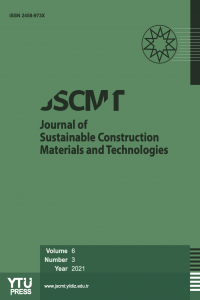Investigating the Effects of Straw & Rice Husk on the Compressive Strength & Tensile Strength of Adobe Brick
Investigating the Effects of Straw & Rice Husk on the Compressive Strength & Tensile Strength of Adobe Brick
Adobe bricks are extensively used for the construction of adobe houses. The lack of strength is one drawback of these bricks; therefore the soil used to build these bricks is stabilized with several natural stabilizers. This study conducted to compare the effects of commonly used stabilizers, which are straw and rice husk on the compressive strength and tensile strength of adobe. Study provided the experimental data and the analyzed failure pattern of the stabilized and un-stabilized specimens subjected to unconfined compressive strength test and splitting test. From the obtained results, the increase in compressive strength, decrease in tensile strength, increase in the elasticity under compressive loads and no major failure under compression and tension was observed for the specimens containing stabilizers. Results revealed the maximum positive effects of straw than rice husk in improving the adobe’s resistance to the compressive and tensile loads.
___
- 1. E.W. Smith and G.S. Austin, Adobe pressed-earth and rammed-earth industries in New Mexico, NMB. MM (1989).2. E. Lynne and A. Cassandra, Alternative Construction: Contemporary Natural Building Methods, JW.A (2000).3. G. Minke, Building with earth: design and technology of a sustainable architecture, Walter de Gruyter (2012).4. E. Adam and A. Agib, Compressed stabilised earth block manufacture in Sudan, UNESCO (2001).5. H. Houben and H. Guillaud, Earth construction A comprehensive Guide, 1st ed., ITDG (1994).6. B. Sidibe, Understanding Adobe, VITA (1985).7. P. Lertwattanaruk and J. Tungsirisakul, JARS, 5, (2007) 187.8. P. Lertwattanaruk and J. Choksiriwanna, Built, 1 (2011) 54.9. E. Quagliarini and S. Lenci, JCH, 11 (2010) 309.10. R. Jauberthie, F. Rendell, S. Tamba and I. Cisse, Constr. Build. Matr, 14 (2000) 419.11. P. Speare, K. Eleftheriou, S. Siludom, R. Dhir, T. Jappy and T. Telford, Durability of concrete containing rice husk ash as an additive, Int. Sem. Exp. W. Conc. (1999).12. H. Isah, The effect of rice husk on the chemical properties of clay soil, ICCBES (2015).13. P. Monteiro and P. Mehta, Concrete: Structure, properties, and materials, Prentice-Hall (1993).14. IRRI, Report of the Fifth External Programme and Management Review of International Rice Research Institute, FAO-UN (1998).15. H. Molla, Study of stabilized mud brick as an alternative building material & development of models, AAU. (2012).16. Ş. Yetgin, Ö. Çavdar and A. Cavdar, Constr. Build. Matr, 22 (2008) 222.17. J. Akinyele, O. Olateju and O. Oikelome, NIJOTECH, 34, (2015) 672.18. G. Chaudhary, V. Kumar and M. Kumar, An experimental study on the capacity assessment of mud brick with impregnated straw, IIT. Gandhinagar (2016).19. M. Bouhicha, F. Aouissi and S. Kenai, Cement. Concrete. Comp. 27 (2005) 617.20. A.B. Ngowi, Constr. Build. Matr, 11, 1 (1997).21. A. Kumar, B.S. Walia and J. Mohan, Constr. Build. Matr, 20, (2006) 1063.22. N. Sriwattanaprayoon, Engineering Properties of Adobe Brick for Earth Structures, IJERD, 41 (2014).23. P. Walker, The Australian earth building handbook, SAA (2002).24. E.H. Boudreau, Making the adobe brick, Berkeley. CA. (1971).25. R. TC, Recommendations for the Testing and Use of Constructions Materials, RILEM, E & FN SPON, 21 (1994).26. D. Silveira, H. Varum and A. Costa, Constr. Build. Matr, 28 (2011) 36.27. D. Silveira, H. Varum and A. Costa, Constr. Build. Matr, 40 (2013) 719.28. V.Z. Bosiljkov, Y.Z. Totoev and J.M. Nichols, SEM, 20 (2005) 21.29. A. Muthadhi, Studies on production of reactive rice husk ash and performance of RHA concrete, Pondicherry Engineering College, (2010).30. W. Jinwuth, A study into the earthquake resistance of circular adobe buildings, University Technology of Sydney, (2012).
- Başlangıç: 2016
- Yayıncı: Yıldız Teknik Üniversitesi
Sayıdaki Diğer Makaleler
Study of the Influence of Fly Ash and Its Content in Marshall Properties of Asphalt Concrete
Seismic Isolation Systems Against Earthquake Disaster
Effect of Fly Ash and Ground Granulated Blast Furnace Slag on The Strength of Concrete Pavement
Sasui SASUİ, Watcharin JİNWUTH, Sirimas HENGRASMEE
Rethinking sustainability: A research on starch based bioplastic
